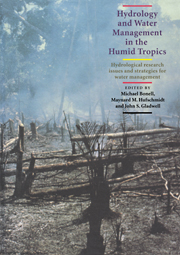 Hydrology and Water Management in the Humid Tropics
Hydrology and Water Management in the Humid Tropics Book contents
- Frontmatter
- Contents
- List of Authors
- Foreword by Federico Mayor, Director-General, UNESCO
- Preface
- Cartographic Credit
- Acknowledgements
- SECTION I INTRODUCTION
- SECTION II HUMID TROPICS SETTING
- SECTION III REGIONAL HYDROLOGY
- SECTION IV PHYSICAL PROCESSES
- SECTION V PHYSICAL PROCESSES – HUMAN USES: THE INTERFACE
- 17 Challenges in Agriculture and Forest Hydrology in the Humid Tropics
- 18 The Impact of Land-Use Change on Water Resources in the Tropics: An Australian View of the Scientific Issues
- 19 Urban Water Management Problems in the Humid Tropics: Some Technical and Non-Technical Considerations
- 20 The Management of Water Resources, Development and Human Health in the Humid Tropics
- 21 Water Supply and Health in the Humid Tropics with Particular Reference to Rural Areas
- SECTION VI MANAGEMENT ISSUES
- SECTION VII APPENDICES
- Place index
17 - Challenges in Agriculture and Forest Hydrology in the Humid Tropics
Published online by Cambridge University Press: 23 December 2009
- Frontmatter
- Contents
- List of Authors
- Foreword by Federico Mayor, Director-General, UNESCO
- Preface
- Cartographic Credit
- Acknowledgements
- SECTION I INTRODUCTION
- SECTION II HUMID TROPICS SETTING
- SECTION III REGIONAL HYDROLOGY
- SECTION IV PHYSICAL PROCESSES
- SECTION V PHYSICAL PROCESSES – HUMAN USES: THE INTERFACE
- 17 Challenges in Agriculture and Forest Hydrology in the Humid Tropics
- 18 The Impact of Land-Use Change on Water Resources in the Tropics: An Australian View of the Scientific Issues
- 19 Urban Water Management Problems in the Humid Tropics: Some Technical and Non-Technical Considerations
- 20 The Management of Water Resources, Development and Human Health in the Humid Tropics
- 21 Water Supply and Health in the Humid Tropics with Particular Reference to Rural Areas
- SECTION VI MANAGEMENT ISSUES
- SECTION VII APPENDICES
- Place index
Summary
ABSTRACT
This paper focuses mainly on the humid tropical and parts of the subhumid tropical subregions of Chang & Lau (1986), associated with the narrow geographic band of about 5° to 7° north and south of the equator. In the humid tropical regions, where precipitation exceeds evaporation for at least 9.5 months per year, Tropical Rain Forest (TRF) is the dominant vegetation in undisturbed conditions and tropical cyclonic influences are absent (Lai, 1987). Occasional reference, however, will be made to the hydrological characteristics of the wet-dry tropical region. The gaps in research knowledge related to the water balance, erosion and sedimentation and change in land-use are addressed. Brief reference is also given to the applications of remote sensing and geographic information systems, and to the problems of scale.
INTRODUCTION
The climax vegetation of the humid tropics regions is tropical rain forest (TRF), which is a diverse and complex system that occupies approximately 10% of the world's area (Golley et al., 1975). The vegetation of TRF is characterized by high plant biomass, concentration of nutrients within the plant biomass and efficient and rapid rates of nutrient recycling which enable this eco-system to sustain itself. The vegetation biomass ranges from 200 to 400 t ha−1 and the number, size and height of tree species within a TRF are highly variable and diverse. In addition, mature TRF has a multi-storey canopy of different strata (Lai, 1986) with a leaf area index (LAI) commonly reported as ranging from 7 to 28.
- Type
- Chapter
- Information
- Hydrology and Water Management in the Humid TropicsHydrological Research Issues and Strategies for Water Management, pp. 395 - 404Publisher: Cambridge University PressPrint publication year: 1993
- 7
- Cited by
